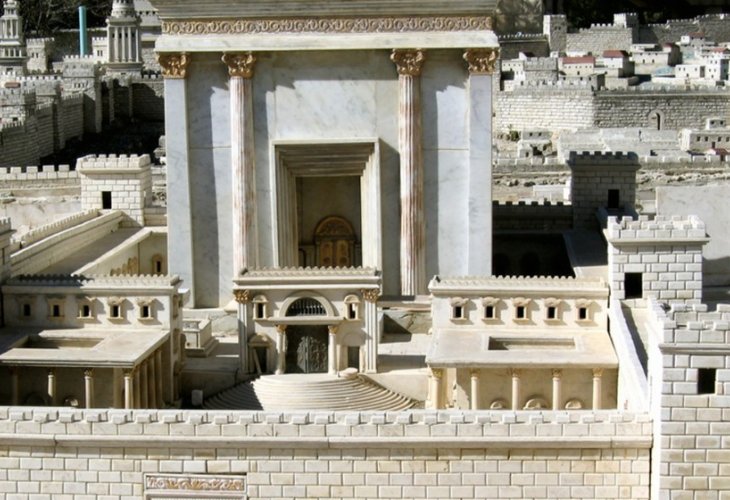History and Archaeology
Connecting Heaven and Earth: How Time, Space, and the Temple Reveal Divine Holiness
The spiritual design of Shabbat, the Temple, and the eternal human mission to unite body and soul in holiness
 (Photo: Shutterstock)
(Photo: Shutterstock)Human life unfolds within the dimensions of time and space, yet our existence does not occur in an empty void. To fulfill his divine mission, the Creator granted man points of connection to holiness — both in time and in place, to reveal the presence of sanctity within the spiritual desolation of the physical world.
Our world is a wondrous blend of matter and spirit, and the human being stands at the meeting point between them. This union is what makes man the crown of creation, the being made “in the image of God.” Holiness (kedushah) therefore means the revelation of the spiritual dimension within material life.
When God commands, “You shall be holy, for I, the Lord your God, am holy,” He is not calling for withdrawal or self-denial, but for the elevation of the physical world toward divine reality.
Holiness in Time — The Power of Shabbat
In the dimension of time, the supreme point of connection is Shabbat, described by the Sages as “a precious gift from My treasury.” On Shabbat, the human soul opens naturally to holiness — the “extra soul” (neshama yetera) descends, and even physical pleasures become sanctified.
Eating and drinking on Shabbat are not animal indulgences but spiritual acts that uplift the body. The prohibited labors on Shabbat are precisely those that anchor man in material control; their cessation allows the soul to rise and reconnect with its divine source.
Violating Shabbat, therefore, means creating a void between matter and spirit, instead of uniting them in higher harmony.
Holiness in Space — The Temple Mount
In the dimension of space, the Beit HaMikdash (Temple) embodies holiness revealed in physical form. It stands as a paradox — earth transformed into sanctity. From this place, say the Sages, the world itself began: the Foundation Stone (Even HaShtiya) beneath the Temple was the origin from which all creation expanded.
It was from this very soil that Adam was formed, and there that God breathed life into him — the ultimate fusion of dust and soul, body and spirit. Thus, the Temple Mount is the root of the connection between heaven and earth.
Even the name Mount Moriah expresses this duality: Moriah means both “instruction” (for divine teaching emanates from there) and “vision” (for there, God reveals Himself to His creation). Likewise, Yerushalayim unites “awe” (yirah) and “peace” (shalom) — a place where reverence and harmony meet.
The Pilgrimage Festivals — Ascending to See the Divine
When the Temple stood, every Jew was commanded to appear before God there three times a year — on Passover, Shavuot, and Sukkot. This was not merely a journey but an ascent, both physical and spiritual, known as Aliyah L’Regel.
It was called the Mitzvah of “Re’iyah” (Seeing) — the time when one could see and be seen by the Divine Presence. Ancient accounts describe the pilgrimage as an event of tremendous joy, elevation, and holiness, central to Israel’s spiritual and economic life.
Even non-Jews felt drawn to the Temple. At the dedication of the First Temple, Shlomo Hamelech prayed that God would also answer the prayers of the stranger, for the Temple was meant to be “a house of prayer for all nations.”
The Sages taught: “If the nations of the world knew how much blessing they receive from the Temple, they would have built it themselves with their own hands.”
To this day, the Temple’s power continues to inspire not only Jews but people of all nations who sense that the world’s hope is bound to that holy place.
The Meaning of the Sacrifices
The holiness revealed in the Temple was not purely spiritual; it also transformed the material world. The sacrifices (korbanot) were not acts of destruction but of elevation and repair. The very word korban comes from karov — “to draw near.”
The offering of an animal symbolized the refinement of the human’s animal nature. When offered with confession and repentance, the act united the lower and higher realms — bringing body and soul, earth and heaven, into harmony.
Awaiting the Return of Holiness
Today, we live in a world without the full presence of holiness.
We can experience spirituality, but without the Temple, we lack the complete link between the physical and divine dimensions.
Only when the hearts and souls of humanity yearn again for God, through the rebuilding of the Temple, will we witness the renewal of holiness in space. Then, the words of the prophet Micha will be fulfilled: “In the end of days, the mountain of the House of the Lord shall be established on the top of the mountains, and many nations shall stream unto it, saying: Come, let us go up to the mountain of the Lord, to the house of the God of Jacob, and He will teach us His ways, and we will walk in His paths.” (Micha 4:1–2)

